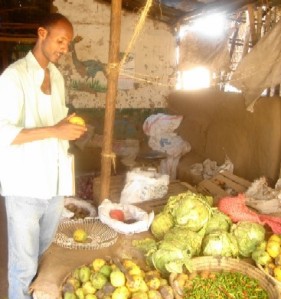
Volume 1, Issue 1 / December 2008
“Little food, more drinks.” It’s a saying you will hear many refugees quote as they discuss the food situation here in Kakuma Refugee Camp.
Currently, a global food crisis that threatens the world economy. Here in Kakuma, the food crisis does not refer to this international phenomenon but to daily food security for refugees.
Due to the camp’s location in a semi-arid zone, there are very few agricultural activities practiced in the camp and its surroundings. The main economic activity of local peoples is livestock farming. Food commodities sold in Kakuma markets come as far away as Kitale town, about 600 kilometers away from the camp.
. A high percentage of locals cannot afford to eat three meals a day. They are provided with food relief by the Kenyan government and Oxfam. Refugees are entirely dependent on food donations channeled through the World Food Programme (WFP) and UNHCR. These food rations consist of dry goods including wheat flour, maize grains, pulse and cooking vegetable oil, and salt. Fruits are not distributed either to refugees or locals.
In the camp, these foot items are purchased from the markets. Shoppers can purchase mangoes, oranges, and pineapples with their own money from the markets. This also applies to green vegetables, meat, poultry, and fishes. The types of food available are limited, however, and refugees generally do not have enough money to purchase to their satisfaction.
“The food rations are to keep us from dying and also not to live,” reports one refugee living in Zone Five. “It is given to me for 14 days, and yet I can it in five days if I mean eating well! I think it is like a medicine dose.” Another refugee takes a similar perspective: “Food is a fundamental human right, and I never have enough.”
Hotels and Food Hygiene
With its multinational population of refugees, Kakuma camp is able to offer a range of regional foods. Almost every community member holds their own cultural habits and attitudes towards food eating and preparation. Ethiopians enjoy eating “njera”(a fried flatbread made of fermented wheat and maize) as their favored staple. Somali favorite foods include chapati (fried pancakes made of wheat flour), while Kenyan locals eat maize ugali (thick, boiled maize flour) and “githeri” (mixture of maize, beans, and vegetables). Sudanese enjoy eating “kisla” (fermented maize flour fried in oil), while Congolese savor cassava ugali (dense, boiled cassava). Burundians, Rwandans, and Ugandans feel most at home when they eat “matuke” (mashed banana stew).
The camp is scattered with an abundance of “hotels,” a general name given to any shelter selling food. These hotels fall into different levels or classes depending on the prices of and types of foods they prepare. In standard refugee hotels you can find the regional cultural dishes preferred by communities. For example, Ethiopian hotels such as Franco Hotel serve njera, soft drinks, and some types of beers brewed locally in Kenya. They occasionally cook rice as an alternative food for customers. Somali hotels such as Nile and Mia provide a variety of snacks, lunches, and supper foods. You can find “pilau” (rice with spices, meats, and vegetables), spaghetti, meat, chapatti, and sometimes ugali. At these standard hotels, prices vary from 40 KenyaKenya shillings for a meal. shillings to 150
Lower standard hotels serve the majority of the refugee and local population. They are cheap, convenient, and serve such foods as strong tea, “mandazi” (fried dough), and beans. Young men who ride bodabodas (bicycle taxis) prefer to have their breakfast and lunches in these hotels.
“Hotel business is good because we help people get food and money. But also we have many challenges,” reports one refugee hotel owner in the camp. “There aren’t enough water and foods that are distributed in the camp such as rice, meat, and vegetables. This makes the business harder and reduces our benefits. We depend on Kenyan supply which is not constant, especially on side of vegetables and fruits. They overcharge us to by these items from them.”
The responsibility for food hygiene in the camp falls to the public health workers who ensure that all hotels meet Kenyan health standards in running hotels with minimum food hygiene. In standard hotels, food hygiene meets these criteria from preparation to serving, rooms, and other food handling facilities. In the lower standard hotels, water for washing utensils and latrines for customer use are questionable. Rooms or shelters are cheaply constructed and contravene the hygiene requirements. Yet these hotels continue to serve many people.
Food handlers in both categories of hotels have not been medically checked. In other institutions, such as schools, women catering groups and all food handlers are medically checked before they are engaged in their work. These efforts should be extended in the private hotels to safeguard the populations they serve.
